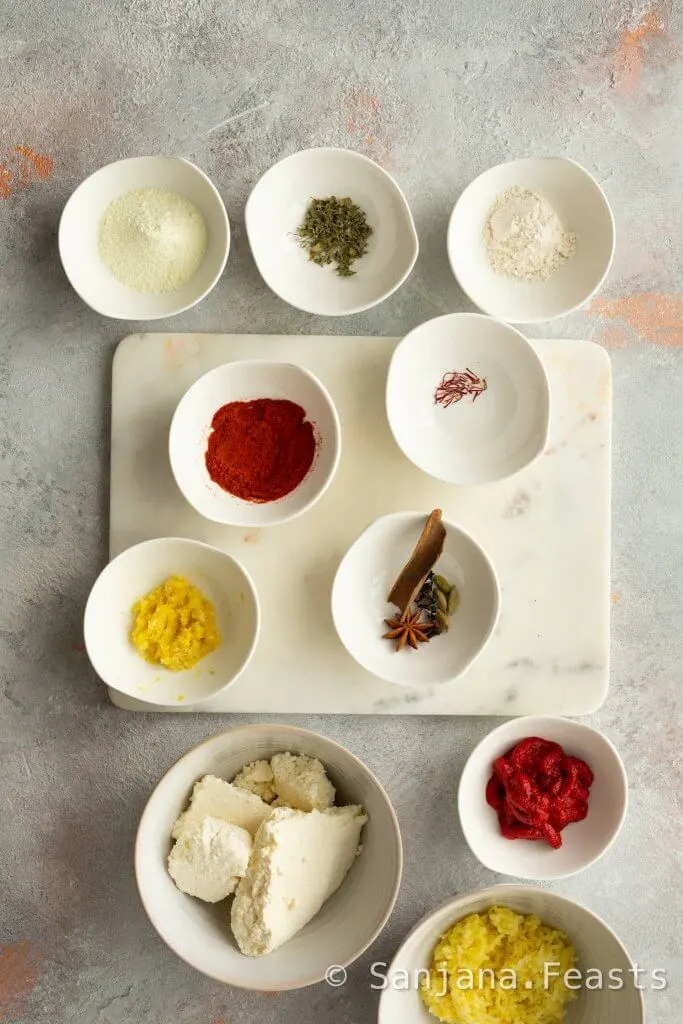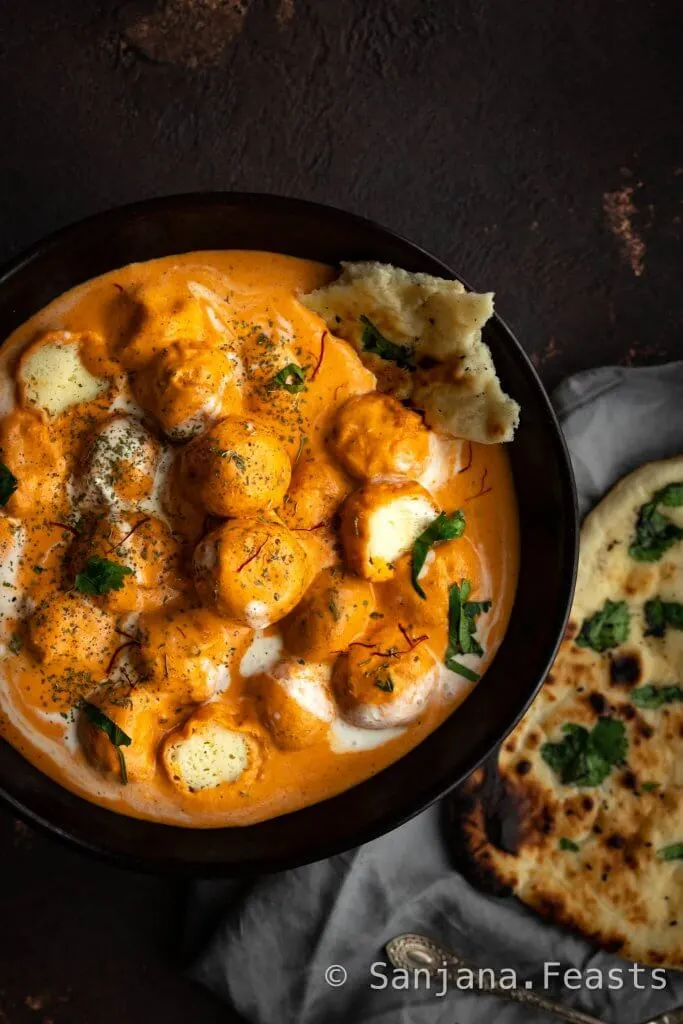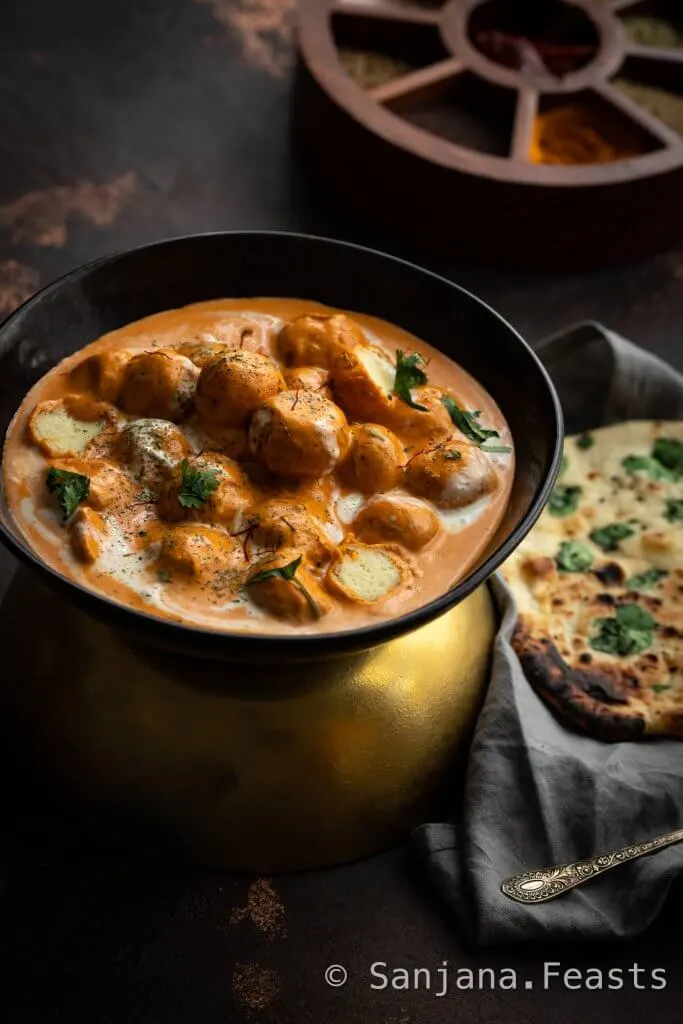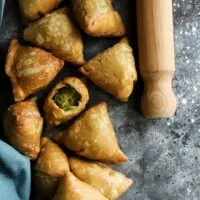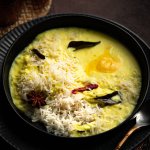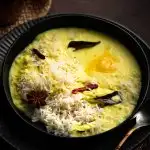Malai Kofta are the ultimate North Indian vegetarian curry recipe to dazzle friends and family. My simple paneer and potato kofta are golden on the outside and a brilliant white colour on the inside. Each bite is soft, a little spongy and slick with a smooth and creamy tomato sauce. In my home, Malai Kofta is an essential curry for special occasions. This Indian vegetarian curry of paneer (cheese) and potato kofta is a real celebration of rich flavours and warming spices.
What is Malai Kofta?
Malai Kofta is a delicious North Indian vegetarian curry, popular in restaurants and for celebrations like weddings and parties. It’s rich, creamy and utterly delicious with naan, paratha or rice. Recipes for Malai Kofta vary from cook to cook. “Malai” refers to the liberal use of cream in the dish, while “Kofta” allude the balls of deep-fried paneer (a vegetarian take on meat kofta, so to speak). Many recipes also include potatoes and/or other vegetables in the kofta mixture. A filling of chopped nuts and sultanas is commonplace, too.
Where does Malai Kofta come from?
It’s said that Malai Kofta has roots in Mughlai cuisine; a style of cooking that goes back to the Mughal Empire and its’ royal kitchens. Originally from Central Asia, Turkey, Persia and beyond, Mughlai cuisine introduced dishes like Biryani, Nihari, Korma, Keema and Pasanda to the Indian subcontinent. You will now find hundreds of delicious variations of these and more dishes across India, Pakistan, Afghanistan and Bangladesh. They are often rich, luxurious and meat heavy. Ingredients like nuts, saffron, rosewater and dry fruits are found in both sweet and savoury dishes of the Mughlai kitchens. Notable vegetarian Mughlai-influenced dishes include Malai Kofta, Shahi Paneer, Korma, as well as desserts like Shahi Tukda, Falooda and Sheer Khurma. There are two popular styles of Malai Kofta. Let’s explore them a little.
Mughlai Malai Kofta (Shahi Malai Kofta) – White in colour
This royal preparation of Malai Kofta is heavily inspired by the customs, techniques and ingredients of Mughlai kitchens. The white-coloured gravy is an ode to the royal emperors’ tastes for all things expensive (namely nuts, but also spices like cardamom, saffron and peppercorns). Make this white gravy by first blanching almonds and/or cashews in hot water, then grinding to create a smooth and creamy paste. Fry off some spices and add the paste, but don’t let it brown. Copious amounts of cream and a pinch of sugar to finish, of course.
Punjabi Malai Kofta (North Indian-style Malai Kofta) – Orange or red in colour
Punjabi Malai Kofta is the version of the dish we most commonly find in restaurants. It’s an adaptation of the Mughlai dish that puts tomatoes to work, hence the orange or red gravy. Tomatoes and chillies were not introduced to India until the 15th and 16th centuries so you could say this is a more ‘modern take’ on Malai Kofta. Over the years, recipes have changed and adapted with tastes and the movement of people. Each Malai Kofta recipe you’ll find online, in books or by word of mouth will be as unique as it is delicious.
Is this a Nut-free Malai Kofta recipe?
Yes, my recipe for Melt-Away Malai Kofta is incidentally, completely nut free. Most recipes for Malai Kofta will contain an assortment of nuts and raisins in the kofta filling and either cashews or almonds to thicken the gravy (sauce). Now, I’ve never been a fan of crunchy nuts in my creamy kofta, although it is is typical of restaurant-style Malai Kofta. A while back, I asked my Instagram community to vote on whether they like nuts and raisins in their Malai Kofta. An overwhelming 83% of 6,000 respondents said no. To make this suitable for those with nut allergies and intolerances, I decided to cut all the nuts out, even in the sauce. So here it is: A creamy, nut-free Malai Kofta recipe that tastes like a restaurant version!
What is Malai in Indian food?
In Indian cookery, the term ‘Malai’ refers to the cream extracted from heating whole milk (sourced from cattle: Either cow or buffalo). It’s used for making a range of dishes, both sweet and savoury. Some dishes include: Malai Kofta, Malai Peda, Rasmalai and Kulfi.
How to serve Malai Kofta
Serve Melt-Away Malai Kofta with your choice of Indian accompaniments, such as Naan, Paratha or Rice. I simply adore the combination of Malai Kofta and Garlic Naan. Some recipes call for placement of the Kofta to be a last-minute affair, directly on top of the hot gravy. My recipe requires a gentle simmer to plump up the Kofta before serving. This gives them their mouth watering melt-away texture.
Why is it called Melt-Away Malai Kofta?
I’ve been making versions of this dish for years. Take a look at this delicious Paneer Kofta recipe from my archives.
Important tips for making this recipe
Paneer
Homemade paneer works best in this recipe. Refer to this recipe for Homemade Paneer. Make sure the paneer is very well pressed, overnight or for as long as possible. Chill in the fridge until ready to use. The paneer should be dry and crumbly. If it is not properly pressed, the kofta may break in the oil while frying.
Potatoes
I use a floury variety of potato in my recipe. Maris Piper or King Edward if you’re in the UK. Any mealy potato you’d use for baked potatoes is ideal. Cook the potato however you like. I like to microwave mine in the skin until soft because it’s super quick and easy. It also draws water out of the potato rather than putting water in, like boiling does.
Once the potato is cooked grate it on the fine side of a cheese grater. It’s best to allow it to cool a bit first!
Kneading kofta mixture
Spend a bit of time kneading the kofta mixture. Use the heel of your palm to press the mixture into the worktop and away from you. We are creating a smooth-textured dough without a crumbly texture. This process is similar to kneading chhena (paneer) for sweets like Rasmalai and Rasgulla. It produces the perfect smooth and creamy finish.
I spent about 5 minutes per portion, so 15 minutes kneading in total. It’s a great work out! I don’t recommend using a blender for this as it can overwork the mixture and ruin the texture of the kofta.
Frying kofta
Heat the oil to 125°C/260°F on a cooking thermometer. It should be low enough to seal the kofta all around without browning too quickly. If you don’t have a cooking thermometer, drop one of the kofta into the oil – it should bubble around the outside very slowly. The kofta need to be fried very slowly until they turn golden. Each batch will take around 10 minutes. Keep them moving in the oil all the time for even browning. If the heat is too high the outside will brown too quickly and they will deflate as soon as they come out of the oil. I do not recommend baking or air frying the kofta.
Sauce/gravy
Since we use tomato purée in the recipe, there is no need to strain the gravy after we blend it. I love the punchy tang of tomato purée in this recipe. Fresh tomatoes don’t even come close. Skimmed milk powder and fried onions will thicken the sauce beautifully in the absence of nuts. You can replace it with 8-10 cashews, soaked in boiling hot water for 30 minutes. Be sure to remove large whole spices like star anise and cinnamon from the onion masala before you blend it. They can ruin the colour! For a bright colour, slowly sizzle Kashmiri chilli powder in warm ghee or oil before adding the gravy mixture. It has a mild flavour and great colour. If you can find this, use half the amount of regular chilli powder and supplement with a teaspoon of paprika (not smoked paprika).
Can I make vegan Malai Kofta using this recipe?
I have not tried veganising this Malai Kofta recipe. I’d imagine quite a few significant changes would need to take place in order to make a vegan Malai Kofta with this recipe. I recommend checking out this Vegan Malai Kofta recipe by Nisha at Rainbow Plant Life.
Subscribe to my YouTube channel!
Is this recipe for Malai Kofta gluten free?
The kofta contain plain wheat flour. Feel free to swap this for rice flour or your favourite gluten-free baking flour. Use a gluten-free baking powder.
How to make Homemade Paneer
My recipe below is best made with Homemade Paneer. Although, if you don’t have time and want to use shop-bought, I’ll totally forgive you. Please do your best to find the softest paneer possible. Malai Paneer is perfect.
Melt-Away Malai Kofta recipe
Pin this recipe for later!
If you like this, you’ll love my recipe for Restaurant-Style Shahi Paneer
More recipes you might like
Love Sanjana Share this recipe



